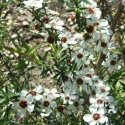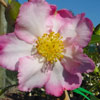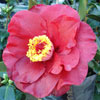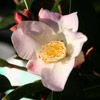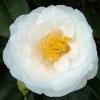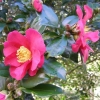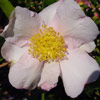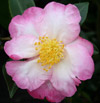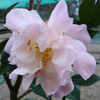Our weekly email news letter. Sign up here to get them delivered straight to your email in box. See below for previous issues...
Please note that product availability and prices may have changed from when this newsletter was sent. Please check this site or phone us for current availability and pricing.
Friday 28th April, 2017
Hi
To Bee or not to Bee.....
I had to go to our hay shed recently, keeping in mind that this is not usually my domain, and as I walked in I noticed a bale at the top of the stack that looked like the end of it had blowflies swarming all over it. Thinking some small creature must have died up there I climbed the stack to investigate further only to find that it was in fact a large wasp nest in the making. I can't say I have ever considered that wasps would make a nest on a hay bale but googling it later I find they will make a nest anywhere that is not disturbed. Initially I thought it was a beehive but once I got a closer look I could see outer shell of the nest was a wavy pattern of what looked a bit like paper mache and I know from past experience that bee's don't do that and then as I got closer I could see the wasps clearly. I have contacted a beekeeper to see if anyone is able to come poison them for me as I know how destructive the wasps can be to the local bee population and apparently a wasp nest can become huge so the sooner it is gone the better.
Recently we had a large beehive removed from one of the
Kahikatea trees when we had them limbed up a while ago and have had an occasional wild swarm collected of a fence post in the past. I always try to look after our bee population with plenty of diversity in plants they are able to feed on.
Leptospermums of all types are visited by bees but their favourite has to be
Leptospermum scoparium our native Manuka followed closely by Kunzea Ericoides our native Kanuka. Another wonderful source of food for bees are Camellia flowers. They flower during important seasons in the life cycle of bees, when there are few other plant species in flower. Camellias are particularly valuable over autumn, when bees are storing pollen for winter use, and also during early spring, when bees are building up their populations and research has confirmed that camellias have high-quality, protein-rich pollen so choose camellia flowers with large clusters of prominent stamens and lots of pollen.
Fairy Blush,
Apple Blossom,
Bob Hope,
Coronation,
Crimson King,
Exquisite,
Gay Border,
Guilio Nuccio,
Koto no Kaori,
Lutchuensis,
Moonlight Magic,
Mothers Day,
San Dimas,
Silver Anniversary,
Silver Column,
Sinensis,
Yuletide are just a few examples of the type of camellia flower the bees will be most benefited by.
Griselinia Broadway Mint always impresses with it's lovely glossy green foliage, wavy margins and it's vigour. Down to $9.99 ea
The temps are getting cooler and the colour is developing on the Awanui tree avenue here in the nursery. Raking will have to be added to the must do list very soon I think. I must admit to enjoying the cool clear windless days that we are so often gifted here in the Waikato even if they do start with a heavy fog as it did this morning. Here's hoping you all have a great gardening weekend while the weather is so temperate. Stay safe and don't forget to get out and enjoy your gardens with a nice drop of your favourite drink.
Ciao
Lloyd, Harry and the Wairere Team
Make it a Wairere weekend where even GNOMES know that gardening's not a drag.
Archived by year 2022 | 2021 | 2020 | 2019 | 2018 | 2017 | 2016 | 2015 | 2014 | 2013 | 2012 | 2011 | 2010 |
2017 Newsletters...
1st one for 2017 (26th January, 2017)
Grapefruit (2nd February, 2017)
Party time (10th February, 2017)
17 Feb (17th February, 2017)
Asteraceae (24th February, 2017)
Autumn Its Official 03032017 (3rd March, 2017)
The Camellia story (10th March, 2017)
Roses Half Price (16th March, 2017)
Clipped Camellias (23rd March, 2017)
Red and gold (31st March, 2017)
Wairere Newsletter 7th April (7th April, 2017)
A wet season indeed (13th April, 2017)
Form and texture (21st April, 2017)
..... To Bee or not...
Mothers Day (10th May, 2017)
Its Rose time again (19th May, 2017)
Winter colour (24th May, 2017)
Roses blooms (1st June, 2017)
Healthy roses (8th June, 2017)
Birthday brekkie (14th June, 2017)
winter solstice (22nd June, 2017)
Rose Names (29th June, 2017)
Dry July (7th July, 2017)
Dry July nearly half way (13th July, 2017)
school holidays (20th July, 2017)
Tree time (27th July, 2017)
unoffical spring (3rd August, 2017)
Signs of spring (11th August, 2017)
Tui cherries are blooming (18th August, 2017)
Sunshine at last (24th August, 2017)
slugs and snails (1st September, 2017)
Never fail choc cake (7th September, 2017)
Never fail choc cake (8th September, 2017)
sandpaper vine (15th September, 2017)
In the beginning (21st September, 2017)
The Villa (29th September, 2017)
Montanas (6th October, 2017)
Crepe Myrtles (13th October, 2017)
Te Aroha Airport (18th October, 2017)
Kumara plants are in (20th October, 2017)
French Tarragon 2 (27th October, 2017)
Trees (3rd November, 2017)
what happening (15th November, 2017)
Xeronema (17th November, 2017)
Summer Watering (25th November, 2017)
Officially summer 2 (1st December, 2017)
Wairere Newsletter (8th December, 2017)
Xmas Summer Holidays (22nd December, 2017)
Wairere Nursery
826 Gordonton Road, R D 1, Hamilton 3281 Ph: (07) 824 3430 Email:
